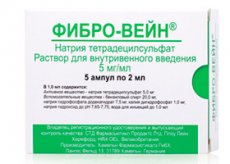Medical expert of the article
New publications
Preparations
Fibro Vein
Last reviewed: 04.07.2025

All iLive content is medically reviewed or fact checked to ensure as much factual accuracy as possible.
We have strict sourcing guidelines and only link to reputable media sites, academic research institutions and, whenever possible, medically peer reviewed studies. Note that the numbers in parentheses ([1], [2], etc.) are clickable links to these studies.
If you feel that any of our content is inaccurate, out-of-date, or otherwise questionable, please select it and press Ctrl + Enter.

Fibrovein is a medicine used in the case of varicose veins. Its active component is sodium tetradecyl sulfate, which has a sclerosing effect.
A thrombus is formed in the area of irritation, closing the lumen in the area of the vein dilated by varicose veins. After intravenous administration of the drug, irritation of the venous endothelium (of the vein dilated by varicose veins) occurs, as a result of which parietal adhesion, fibrosis, and partial or complete venous obliteration begin, which may be transient.
 [ 1 ]
[ 1 ]
Indications Fibro vein
Therapeutic forms of the drug 0.2%, as well as 0.5% and 1% are used for sclerotherapy by injections for lesions of superficial and small veins on the legs.
3% liquid is used for varicose veins affecting the legs.
 [ 2 ]
[ 2 ]
Release form
Dosing and administration
The drug should be used intravenously (it can also be prescribed to elderly people).
Application of 0.2% injection fluid – 0.1-1 ml of the substance is injected into the lumen of an isolated venous segment (each of 10 zones) with subsequent compression. No more than 10 ml per portion can be used.
0.5% and 1% solutions are used according to the scheme indicated above, but the portion of such injections in this case is 0.25-1 ml of the substance.
3% liquid in the amount of 0.5-1 ml is injected into the area of 4 zones of the lumens of the isolated venous segment with subsequent compression. No more than 4 ml of the drug is allowed to be injected.
Use Fibro vein during pregnancy
There is no information on whether Fibro Vein is safe to use during pregnancy. There is also limited information on the use of sodium tetradecyl sulfate during this period. It is recommended to start therapy after childbirth.
There is no data on whether the active ingredient of the drug passes into breast milk.
Contraindications
Main contraindications:
- severe sensitivity associated with sodium tetradecyl sulfate or other components of the drug;
- inability to walk (any reason);
- high probability of thrombosis (individuals with a tendency to thrombosis);
- period of use of hormonal contraception;
- period of HRT;
- people with severe obesity;
- patients who smoke regularly;
- conditions in which there are restrictions in movement;
- history of superficial thrombophlebitis in the active phase, pulmonary embolism or DVT;
- recent operations;
- varicose veins, which arise due to neoplasms in the abdominal or pelvic area in cases where they have not been removed;
- common pathologies that cannot be controlled – toxic hyperthyroidism, asthma, diabetes mellitus, tumors, tuberculosis, sepsis, acute respiratory infections and pathological changes in blood parameters;
- epidermal diseases (for example, evolutionary oncology);
- severe valvular insufficiency affecting the deep veins;
- arterial pathologies of occlusive nature;
- an increase in the size of superficial veins, which also extends to deep veins;
- migratory phlebitis;
- active phase of cellulite;
- acute infections.
Side effects Fibro vein
Side effects include:
- immune disorders: urticaria, shock and bronchial asthma often appear. Allergy symptoms develop sporadically, such as anaphylaxis;
- problems with the functioning of the nervous system: paresthesia, dizziness, migraine or weakness, headaches, as well as vasomotor manifestations (for example, loss of consciousness) occur sporadically. In addition, stroke, hemiplegia or hemiparesis, increased heart rate, as well as nerve damage associated with extravasation of the drug and temporary ischemic stroke develop sporadically;
- damage to the visual organs: scotoma appears occasionally (may have a flickering character);
- vascular dysfunction: phlebitis or thrombophlebitis often occur. Sometimes the vascular web at the site of drug application intensifies. DVT (usually peripheral or muscular veins), vasculitis, pulmonary embolism, heart failure or vascular insufficiency develop sporadically, as well as peripheral tissue necrosis in the area of intra-arterial injection, which can provoke gangrene (often observed with injection into the area of the posterior tibial artery, located above the medial malleolus), or arterial spasm;
- problems with respiratory activity: occasional dyspnea, cough or a feeling of tightness in the chest area;
- digestive disorders: diarrhea, vomiting, swelling of the tongue, nausea and dry mouth are observed occasionally;
- epidermal lesions: sometimes local skin signs of allergic or non-allergic nature (for example, erythema, swelling, dermatitis or urticaria) and hyperpigmentation appear. Less often, ecchymosis or hematoma occurs, as well as necrosis of nerve fibers with peripheral tissues;
- systemic disorders: most often there is a short-term burning sensation or pain in the injection area. Occasionally there is a feeling of heat or fever.
Overdose
Increasing the required doses of Fibro Vein when administered into the area of small vessels may cause tissue necrosis or pigmentation.
 [ 14 ]
[ 14 ]
Storage conditions
Fibrovein should be stored in a dark place, out of the reach of small children. Temperature marks - no more than 25°C.
 [ 15 ]
[ 15 ]
Shelf life
Attention!
To simplify the perception of information, this instruction for use of the drug "Fibro Vein" translated and presented in a special form on the basis of the official instructions for medical use of the drug. Before use read the annotation that came directly to medicines.
Description provided for informational purposes and is not a guide to self-healing. The need for this drug, the purpose of the treatment regimen, methods and dose of the drug is determined solely by the attending physician. Self-medication is dangerous for your health.

